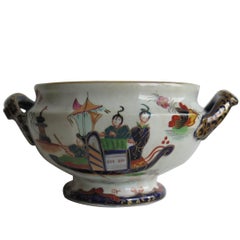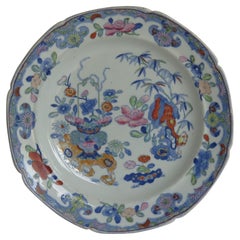Clay Ceramics
1
to
1
1
1
1
195
75
20
19
5
3
1
1
1
4,447
151
65
60
59
1
1
1
Style: Georgian
Material: Clay
Ridgway Rare Early Drabware Basket & Stand
Located in Bishop's Stortford, Hertfordshire
A very rare antique English Georgian early Ridgway hand painted drabware twin handled fruit basket and matching stand dating from around 1802. Made at the Cauldon Place Works the bas...
Category
Early 19th Century English George III Antique Clay Ceramics
Materials
Clay
Related Items
John Ridgway Ironstone Bowl Hand-Painted pattern, William 1Vth Circa 1835
Located in Lincoln, Lincolnshire
This is a highly decorative, ironstone, twin handled circular footed Bowl by John Ridgway, dating to the English William 1Vth period, circa 1835 .
The bowl has been carefully hand-painted in bold colorful enamels with a chinoiserie pattern of three oriental people travelling on a boat, pattern number 5057. It is also richly hand gilded.
John Ridgway operated at his father’s celebrated Cauldon Place works, Shelton, Hanley, England, between 1830-1856, producing some fine porcelain and stone China of excellent quality. His stone China earthenwares and ironstone wares are discussed on page 305 of Godden's Guide to Ironstone, Stone and Granite Wares written by Geoffrey Godden for the Antique Collectors Club.
This piece is fully marked to the base with an Imperial Stone China...
Category
Mid-19th Century English Chinoiserie Antique Clay Ceramics
Materials
Ironstone
H 3.25 in W 6.63 in D 5.38 in
Georgian Mason's Ironstone Dish or Plate in Bamboo & Basket Pattern, circa 1817
Located in Lincoln, Lincolnshire
This is a very decorative dish or plate by Mason's Ironstone, Lane Delph, England in the Bamboo and Basket pattern, dating to the early 19th century, Georgian period, circa 1813-1820...
Category
Early 19th Century English Chinoiserie Antique Clay Ceramics
Materials
Ironstone
Antique English Late 18th Century Yorkshire or Staffordshire Basket
Located in Charleston, SC
Rare antique English Yorkshire or Staffordshire creamware pierced basket with intricate reticulated body. Lovely color no damage or repairs.
Category
Late 18th Century English Antique Clay Ceramics
Materials
Creamware
Rare Dutch Majolica Plate with Tulip, Early 17th Century
Located in AMSTERDAM, NH
A rare Dutch Majolica plate with a decoration of a tulip.
Northern Netherlands, probably made in the city of Rotterdam.
Made 1620 - 1640
Dutch majo...
Category
Early 17th Century Dutch Renaissance Antique Clay Ceramics
Materials
Ceramic, Majolica
Wedgwood Drabware Sugar Bowl and Stand England, circa 1825
By Wedgwood
Located in Katonah, NY
Wedgwood made this drabware sugar bowl and stand in Staffordshire, England, in the first quarter of the 19th century, circa 1825.
The design is simple and elegant, and the decoratio...
Category
Early 19th Century English Regency Antique Clay Ceramics
Materials
Earthenware
Georgian Mason's PAIR of Mugs Ironstone in Chinese Scroll Ptn very rare, Ca 1818
Located in Lincoln, Lincolnshire
These are a matching PAIR of Ironstone pottery mugs made by the Mason's factory at Lane Delph, Staffordshire, England and is decorated in the Chines...
Category
Early 19th Century English Georgian Antique Clay Ceramics
Materials
Ironstone
H 3.25 in W 4.25 in D 3.13 in
Wedgwood Jasper-Dip Pierced Orange Basket
By Wedgwood
Located in New Orleans, LA
One of Wedgwood’s most acclaimed “useful wares,” this fine jasper-dip pierced orange basket displays a brilliant cobalt blue and white checkerboard patte...
Category
19th Century English Other Antique Clay Ceramics
Materials
Ceramic
Antique Drabware Dish Showing Bird Made by Job Ridgway 1802-1808
By Minton
Located in Katonah, NY
Made in England by Job Ridgway 1802-1808, this incredibly rare oval-shaped Drabware dish shows a hawk perched on a log. The image is crisp. According to the online Ridgway pattern bo...
Category
Early 19th Century English Neoclassical Antique Clay Ceramics
Materials
Earthenware
Mid-Century French Hand Painted Barbotine Ceramic Fruit Basket Centerpiece
Located in Dallas, TX
Decorate a tabletop with this colorful, majolica basket composition. Crafted in France circa 1960, the centerpiece features a realistic assortment of fruits and vegetables in high re...
Category
Mid-20th Century French Clay Ceramics
Materials
Ceramic, Majolica
Two Pairs of Italian Maiolica Baskets, circa 1780
Located in Milano, IT
Two pairs of maiolica baskets
Antonio Ferretti Manufacture
Lodi, circa 1770-1790
Maiolica polychrome decorated “a piccolo fuoco” (third fire).
Measures: A) Height 3.54 x 6.69 x 9.84 in (9 x 17 x 25 cm);
B) Height 3.93 x 7.48 x 11.02 in (10 x 19 x 28 cm).
Total weight 4.85 lb (2.200 kg)
State of conservation:
A) One of the smaller baskets has some areas of restoration, the other slight chipping from use;
B) One of the larger baskets is intact and the other shows a clearly glued break.
The mold with which the baskets were forged simulates a wicker weave.
The two larger works have high, vertical walls, with branch-shaped handles penetrating the weave. The painted decorations, small polychrome flowers applied only externally, highlight the points where the weaves intersect.
The decision to leave the center of the basket devoid of decoration is highly unusual, but given the size and complexity of the shape, as well as the quality of the enamel, it is possible to hypothesize that it represents a precise choice in manufacturing or for a particular client.
The two smaller baskets have small, twisted handles and, on the outside, reproduce more decisively the characteristic wicker weave, obtained through thin molded lines. The interior exhibits a rich, typical decoration of naturalistic flowers: a bunch centered around a main flower and secondary stems accompanied by small “semis”. The exterior of these works is also adorned with small little flowers where the weaves intersect.
The size and morphological characteristics of the baskets confirm their attribution to the Lodi factory of Antonio Ferretti between 1770 and 1790, during its most successful period; by this point his original reworking of the "Strasbourg" decoration, known as "old Lodi", had achieved great fame even outside Italy.
This decorative choice represented a strong point of the Lodi factory, which established itself thanks to the vivid nature of the colors made possible by the introduction of a new technique perfected by Paul Hannong in Strasbourg and which Antonio Ferretti introduced in Italy. This production process, called “piccolo fuoco” (third fire), allowed the use of a greater number of colors than in the past; in particular, the purple of Cassius, a red made from gold chloride, was introduced. Its use allowed for many more tones and shades, from pink to purple.
The Ferretti family had started their maiolica manufacturing business in Lodi in 1725.
The forefather Simpliciano had started the business by purchasing an ancient furnace in 1725 and, indeed, we have evidence of the full activity of the furnaces from April of the same year (Novasconi-Ferrari-Corvi, 1964, p. 26 n. 4). Simpliciano had started a production of excellence also thanks to the ownership of clay quarries in Stradella, not far from Pavia. The production was so successful that in 1726 a decree of the Turin Chamber came to prohibit the importation of foreign ceramics, especially from Lodi, to protect internal production (G. Lise, La ceramica a Lodi, Lodi 1981, p. 59).
In its initial stages, the manufacture produced maolicas painted with the “a gran fuoco” (double fire) technique, often in turquoise monochrome, with ornamentation derived from compositional modules in vogue in Rouen in France. This was also thanks to the collaboration of painters like Giorgio Giacinto Rossetti, who placed his name on the best specimens next to the initials of the factory.
In 1748 Simpliciano made his will (Gelmini, 1995, p. 30) appointing his son Giuseppe Antonio (known as Antonio) as universal heir. After 1750, when Simpliciano passed away, Antonio was directly involved in the maiolica factory, increasing its fortunes and achieving a reputation on a European level. Particularly important was the aforementioned introduction in 1760 of the innovative “a piccolo fuoco” (third fire) processing, which, expanding the ornamental repertoire with Saxon-inspired floral themes, could commercially compete with the German porcelains that had one of its most renowned offerings in the naturalistic Deutsche Blumen. Antonio Ferretti understood and promoted this technique and this decoration, proposing it in a fresher and more corrective version, less linked to botanical tables...
Category
1770s Italian Neoclassical Antique Clay Ceramics
Materials
Maiolica
Rare Large Antique English Early 19th C. Wedgwood Queensware 'Creamware' Bowl
By Wedgwood
Located in Charleston, SC
Rare & Important Antique English Large Wedgwood Queensware (Creamware) Centerpiece with influences by Robert Adam represented by the swags and fest...
Category
Early 19th Century English George III Antique Clay Ceramics
Materials
Earthenware
H 4.5 in W 15 in D 9 in
Georgian Mason's Ironstone Soup Bowl or Plate Hand painted rare Ptn, Circa 1818
Located in Lincoln, Lincolnshire
This is a very good early Mason's ironstone pottery soup bowl or deep plate hand painted in the Fence, Blue Leaf & Lilac pattern, produced by the Mason's factory at Lane Delph, Staf...
Category
Early 19th Century English George III Antique Clay Ceramics
Materials
Ironstone
Recently Viewed
View AllMore Ways To Browse
White Coffee Mug
Ceramic Candlestick Red
Chinese Porcelain Dish Charger
Antique Spongeware Bowl
Vallauris Faux Bois
Spongeware Bowl Antique
Chinese Porcelain 19th C Bowl
Roger Capron Fish
Pedestal Bowl Chinese
R Silver Plate Italy
Harlequin China
Old Mason Ironstone
Loewe Glasses
Majolica Lily Pad
Bottega Gatti
Ceramic Pucci
Antique Ironstone Mold
Antique Ironstone Molds


